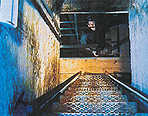
|
|
Apr. 8, 1997 (b)
|
Column Index - Apr. 8, 1997
![]()

The Israel Biennial
Dana & Boaz Zonshine
|
The Israel Biennial
The comprehensiveness reflecting the expansion of scale and the situation Last November, I had the opportunity to visit <<Art Focus>>, the Biennial for contemporary art held in Israel. Following the first event in 1994, this is the second Biennial. The first exhibition was held in the galleries and art museums around Israel mainly featuring artists from Israel, but this time, the locations were narrowed down to 4 cities, such as Jerusalem and Tel Aviv, and the event became one of comprehensive nature including large scale international exhibitions involving overseas artists. This young country established in 1948 and not even reaching its 50th anniversary, on one hand possesses a big, capitalistic city such as Tel Aviv, and on the other hand, has places deeply inscribed with history, such as Jerusalem which has a history of 3,000 years. Although she carries conflicts related to race and religion, Israel, whose official language is Hebrew and which is the spiritual center for the Jews around the world, portrays an extremely high tension concerning profound issues such as history and today, and life and death.
Jerusalem At the city which became the center of the exhibition, Jerusalem, the underground of a gigantic football stadium, artist houses, and national art museums were the venues. The exhibitions were mostly planned by curators from Israel, and though they were international exhibitions, unique ideologies were felt in the choice of themes. For example, "Hide and Seek" was an exhibition based on the theme of the coexistence of two vectors, one in which everything was made visible as the searcher, and the other in which the self was attempted to be hidden. Here, artists with straightforward questions, such as the skepticism towards the development of processing technology of images, and the search for how to make a psychologically deep commitment possible from the viewer while making the image direct, were collected. Also, the group exhibition, "Some Things", which indicated a unique sensibility through the meditational character of the Israeli artists and their way of representing the invisible, was impressive. The way to approach the situation of the avoidance of the political In contrast to Jerusalem, which has a strong spirituality as the Holy Land, Tel Aviv was a city which gave us the impression similar to Miami. Some of the galleries and art spaces were active, and the young artists studied in the United States, learned about contemporary art and the ways to deal with media, and they seemed to be in the midst of trials to portray the country's exclusive problems in expressive language. Also, among the works of artists active within the Kibbutz, which maintains a communistic utopia, though they were not especially political, there were large scale conceptual art which seemed to "re-map" the spiritual world. The exhibition titled, "The Desert Cliche Israel Now - Local Images" held at the Ein Harod Museum of Art in the Kibbutz, was a collection of works based on typical issues such as terrorism and the military, and religious conflicts, and this was to travel to New York later. It was interesting to note that though they carried a tension towards the problems, political suppression towards the expressions were not felt so strongly. In other words, there, it was constantly questioned what art can do in that situation. In Israel, there is a compulsory military service system of two years for men, and one year for women. I talked to a female artist with a skinhead and a supple, muscular body, who had just completed her service. "(One must) bore a hole in the situation" - her graceful manner of speech reminded me of the words of one artist who had said that an artist was a warrior for beauty. [Yuko HASEGAWA/Art History]
|
|
|
|
|
|
|
|
|
Apr. 8, 1997 (b)
|
[home]/[Art information]/[Art Watch]
Copyright (c) Dai Nippon Printing Co., Ltd. 1997
Network Museum & Magazine Project / nmp@nt.cio.dnp.co.jp
